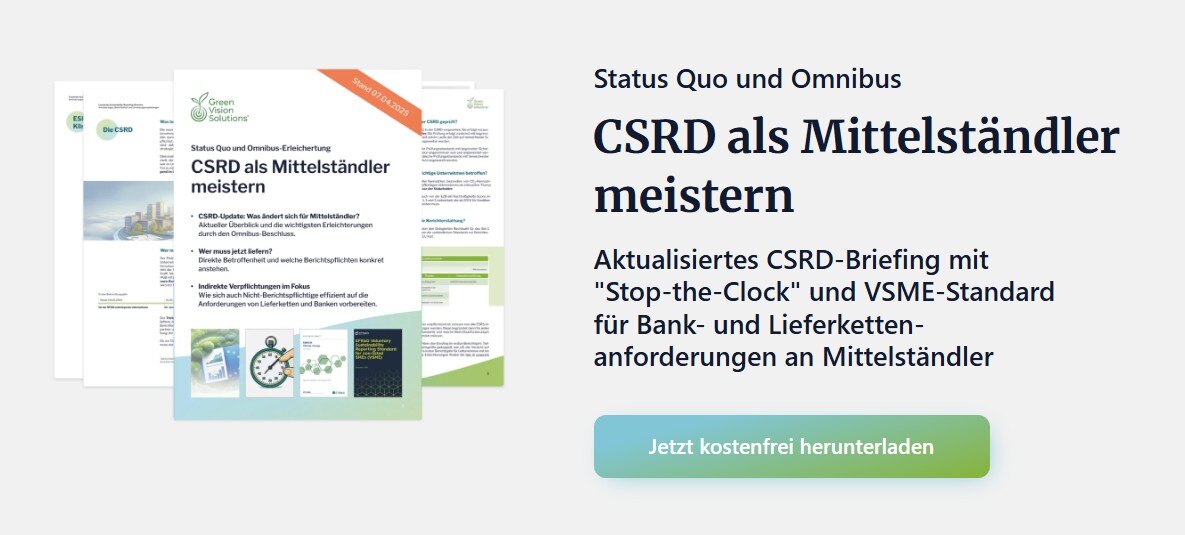More than just software: Your team for carbon accounting
We provide personalized support, a TÜV-certified process, and practical online seminars. → Learn more
The new EU Sustainability Reporting Regulation (CSRD) is shifting the focus to corporate sustainability. In the future, companies will also be required to make their impacts on the environment and society transparent. A key prerequisite for successful CSRD reporting is conducting a materiality analysis. In this blog post, you'll learn what a materiality analysis is, how to proceed, and why collected CO2 metrics are an important prerequisite for conducting a materiality analysis.
| March 10, 2023
🕓 Reading time 6 minutes
April 2025: The Omnibus proposal aims to change the size criteria, the ESRS mandatory standards, and essential requirements. Read the new changes here in the blog post about the Omnibus proposal.
1. Definition: What is the materiality analysis for the CSRD?
CSR reporting is regulated in the EU by the Corporate Sustainability Reporting Directive (CSRD) which requires comprehensive and standardized reporting on sustainability aspects.
The materiality analysis is an important component of this reporting because it helps companies identify the "material" sustainability topics they must report on. To conduct an effective materiality analysis, companies should follow Advisory Standards. The standards provide companies with recommendations for conducting the analysis and help them identify the sustainability topics that are most relevant to their company.
2. Identification of the essential ESRS standards
The topics identified as most important in the materiality analysis are reported using the ESRS standards.
The double materiality analysis required for the CSRD relates to impacts from and on the company's business activities: environmental impacts as well as impacts related to various stakeholders such as employees, customers, suppliers, investors and the community must be assessed.
3. Preparation for the CSRD materiality analysis
There are important fundamental topics that form the basis for the materiality analysis and must therefore always be reported by every company subject to CSRD. For this reason, the content must be created right at the beginning to support the materiality analysis. This fundamental information includes the climate indicators (CO2 indicators) and the general information on the sustainability strategy.
4. CO2-Key figures as central indicators
Carbon metrics play an important role in the materiality analysis for the CSRD. They are key indicators of a company's environmental impact. Carbon metrics enable companies to assess their emissions, identify hotspots and risks, and set reduction targets. By analyzing carbon metrics, companies can not only minimize their environmental impact but also reduce their costs.
An important aspect of the materiality analysis is identifying risks and opportunities related to climate impacts (ESRS E1). Companies need to understand the risks posed by the main contributors to their CO2 emissions in order to take effective measures and minimize emissions. At the same time, companies should also identify opportunities within their current climate strategy to further develop their business in a carbon-friendly manner.

5. Timeline and approach for the CSRD materiality analysis
Step 1: Preparatory data collection
Companies subject to CSRD should already have the CO2 metrics and general information on their sustainability strategy available at this time in order to begin the materiality analysis. If this is not yet the case, it is recommended that this data be collected immediately in order to begin the materiality analysis.
Step 2: Conducting the materiality analysis
It is recommended to start the CSRD materiality analysis as early as possible to ensure that the company has sufficient time to identify all relevant aspects and take the necessary actions to improve sustainability performance. A good time to start the materiality analysis might be once the CSRD reporting obligation has been identified.
Developing a materiality matrix can help identify the most relevant topics. The materiality matrix allows companies to assess the importance of topics and prioritize them based on their impact on the company and its stakeholders.
Step 3: Preparation of the reporting
The topics identified in the materiality analysis must then be addressed and submitted for mandatory reporting in 2024 or 2025.
Conclusion
An effective materiality analysis enables companies to prioritize and address their sustainability issues in a targeted manner.
CO2 metrics are an important prerequisite for a successful materiality analysis within the framework of CSRD reporting and should already be available. Successfully collecting emissions data is the first step toward successfully implementing a company's sustainability reporting.

More than 300 companies rely on our CO₂ accounting
- ✓ TÜV-certified process
- ✓ Personal support instead of an anonymous tool
- ✓ Clearly structured software for easy data entry
- ✓ Result: verified CCF, ready for your communication
- Find out more here
Subscribe to our free climate news (de) and never miss any industry news or articles!
Topics
Latest post
Omnibus Regulation: Far-reaching simplifications for the CSRD
Mehr als nur Software: Ihr Team für CO₂-BilanzenWir begleiten mit persönlicher Beratung, einem TÜV-zertifizierten Prozess und praxisnahen...
Introduction to the CO₂ balance
Calculate your CO2 footprint: This is the data companies need for their carbon footprint
Mehr als nur Software: Ihr Team für CO₂-BilanzenWir begleiten mit persönlicher Beratung, einem TÜV-zertifizierten Prozess und praxisnahen...
Regulatory frameworks
Omnibus Regulation: Far-reaching simplifications for the CSRD
Mehr als nur Software: Ihr Team für CO₂-BilanzenWir begleiten mit persönlicher Beratung, einem TÜV-zertifizierten Prozess und praxisnahen...
Entdecken Sie unsere Seminare & mehr
Find practical training courses on all aspects of greenhouse gas reporting

3.–5.11. | 3 Tage | Online-Seminar
Calculation of the greenhouse gas balance via Scope 1-3
Learn how to calculate GHG emissions yourself - with methods, sources for emission factors and practical relevance

Mi 10.12. | 4 h | Online-Seminar
Materiality analysis and data preparation for CO₂ reporting
Avoid errors and additional effort: Which Scope 1 to 3 data are actually relevant according to GHG?

Do 15.01. | 3 h | Online-Seminar
Scope 3 Data Dilemma
Between data gaps and mountains of data: Coping with GHG in practice




